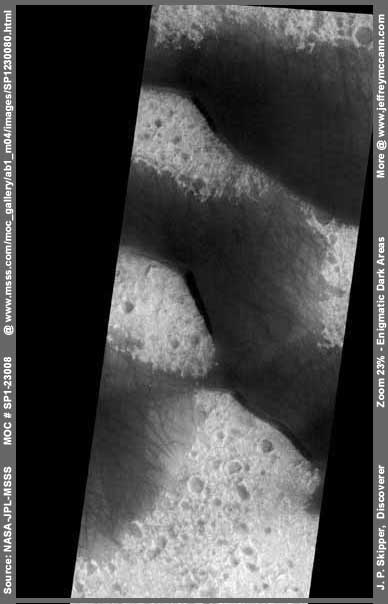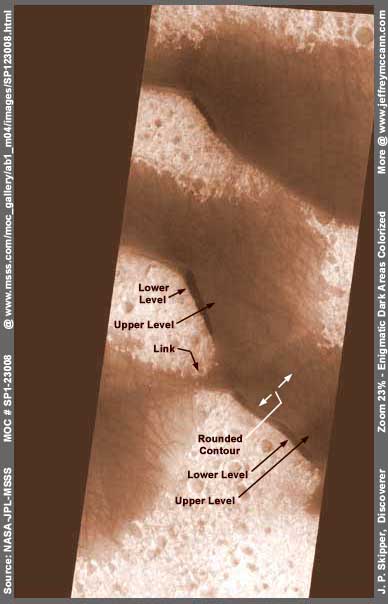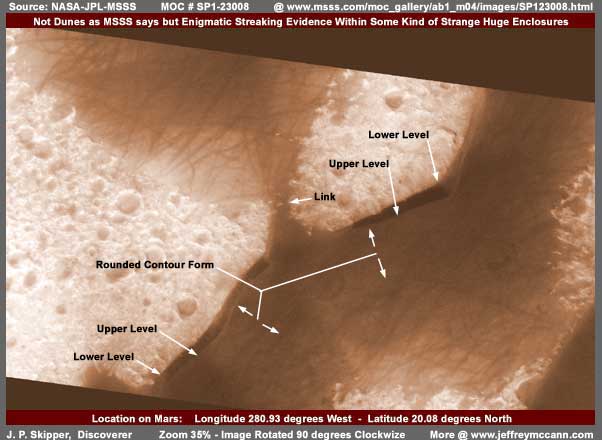

A PUZZLE! WHAT IS THIS?
Report #017
February 26, 2001

The evidence here has been extracted from NASA/JPL/MSSS's original MOC # SP1-23008 narrow-angle image strip. The dark areas you see above are identified on the original MSSS image statistics page as "Large Low Albedo Dunes in Crater." The term "Low Albedo" simply translates to dark dunes which implies that NASA & Co. are identifying the dark areas themselves as dunes rather than being the shadows thrown by dunes. The distinction is important.
Quite frankly, this official explanation is far off the mark. There are no dunes of any kind here, not even any high or low ground to speak of, only relatively level topography heavily peppered with small impact craters and rough ground. Further, that true natural peppered topography has a bright albedo placing it in abnormally sharp contrast with the extremely dark "Dunes."

You should know that the MSSS statistics page indicates that this image covers a path 2.59 km wide which equates to 1.61 miles across. As can be seen in the first black and white image and the above colorized version, these dark anomaly objects are longer across the width of the original image strip than it is wide, so no telling what these anomalies ultimate size truly may be. One thing is for sure, they are very big.

In the above zoomed in colorized image (rotated 90 degrees CW to the horizontal), note that the middle and bottom anomalies here share a connection point which may mean that what we are looking at is just a small part of a much larger interconnected network of these things. I could find no associated context wide-angle image strip that is often found with these MSSS narrow-angle images that might have allowed us to see the larger area this narrow-angle shot was taken from within. So, no luck there.
Even in the first black and white context image here, which I have done nothing to at all other than zoom in a little and crop it out, MSSS's explanation does not address the fact that large areas of these objects clearly have a strong transparent quality to them. Further, completely contrary to the surrounding rough topography with its relatively dense impact crater peppering, these objects are completely smooth demonstrating not a single impact crater and clearly have nothing in common with the topography they are located in. When these factors alone are considered, it seems ludicrous for the experts to be labeling the dark areas as natural "Dunes."
Further, what about all the dark streaking that can be clearly seen in all the images here? Is this not a factor to be considered at all? Do we just ignore it? Note that the streaking marks are thick in number within the inside boundaries of the anomalies and approach right up to the edge of the anomaly mass in great numbers but never cross the edge of the mass into the surrounding natural topography. I would call that a clue! Do we just ignore this inconvenient fact as well?
In the colorized images here, the smooth transparent quality of these anomalies begins to show itself more. Now pay close attention to the left/bottom edge of the middle anomaly. Here we can begin to see that this object has a dark bottom layer and on top of that the much larger lighter colored top main layer constituting the bulk of the anomaly mass.
In the closest view here, we can see that the multitude of streaking appears to cover each anomaly's entire area. In my opinion, the main anomaly bulk's surface has a semitransparent quality to it characteristic of artificial domes. Further, the sharply defined irregular edges also imply dome material attachment to the ground at those edges. Note that where the darker lower level and the lighter upper levels can be seen, the upper level edge at this point appears to be a well defined rounded contoured form. Considering the miles long size of these objects, that rounded contour means that these anomalies are quite high off of the ground which is again consistent with the dome form. So, in my opinion, I believe that we are looking at some giant dome forms of some kind that have been obscured by the dark image tampering coating.
Meanwhile, notice that the dark streaks, looking very much like the streaks that have sometimes been found crossing and crisscrossing large spots on Mars out in the open and which NASA has just recently stated are dust devil trails, do not actually go beyond the edges of the larger anomaly object's perimeter. Again, I repeat, that is definitely a clue!
So, are these dust devil trails dancing around on the surface of "Dune" anomaly objects? I am unable to accept that speculation because not a single streak out of all those many ever leaves the boundaries of the big anomalies although many approach right up to the edge and there is no visible evidence of them in the surrounding ground topography. Could these just be small dust devil trails that show up easily on heavily dusted hard smooth curved dome outer surfaces which fine coating is much easier to disturb and the wind devils are then simply not forceful enough to leave trail evidence on the rougher surrounding terrain? Well that is at least beginning to sound a bit more reasonable to speculate on, especially since I have already found many domes on Mars and a few more here would be no surprise. Could it be that something is going on inside these domes that often generates wind vortexes on the outer top surface of the dome which then quickly looses force and dissipates beyond the confines of the dome where the influence that created them is no longer strong?
On the other hand, could it be that whatever made these streaks may be confined to the hollow interior of these semitransparent giant anomaly objects and we are looking at these streak marks on the ground (just as in other open areas on Mars) within the domes? Many whirling wind vortexes inside a huge dome enclosure that go right up to the very wall edges? That doesn't sound reasonable to me. On the other hand, is it possible that the streak marks are not made by dust devils at all but by something alive both inside these enclosures and out on the surface of Mars? Are these anomaly objects actually artificial preservation or breeding habitats or something less pleasing like prisons or enclosed resource farms?
Or, did the image tampering at our end first take the form of the dark streaks (which I have often suspected in other open topography images) and then the dark broad tamper coating (which I am well familiar with) added as additional covering insurance? Just not enough evidence to speculate with any confidence. Too many questions and not enough good information.
One thing is for sure, these dark areas are not natural "Dunes" as officially presented to us. Yet, there is no way that NASA, JPL or MSSS could make such a simple mistake at their skill level and their going to the trouble of putting the dark broad image tampering coating on these anomalies says that they do not want anyone taking a good look. That is very real and it usually means that these objects are no doubt artificial and something is being hidden from us here. So what do you think these objects are?
DOCUMENTATION
http://www.msss.com/moc_gallery/ab1_m04/images/SP123008.html: The evidence here is taken from NASA/JPL/MSSS's original MOC # SP1-23008 image strip. I down loaded the 1st listed faster loading medium quality sinusoidal jpeg image strip and extracted my evidence here from that. The anomalies in question here are right at the top of the strip. Note that I did rotate the third image here from its vertical orientation 90 degrees clockwise to a horizontal orientation to save room and fit my presentation style. The 2nd listed slower loading best quality sinusoidal gif image has the same correct orientation and will do just as well. WARNING: The 3rd listed slower loading processed but not map-projected gif image strip has been flipped horizontally but not vertically at official level before being released to the public. I have not accessed this data at PDS or USGS and can not comment on it there at those sites. Good Luck!
By the way, this original strip was brought to my attention many months ago by Val Parks, a very skeptical American at that time living in Germany, who thought I might be interested in it as evidence of water implying that the dark areas seen here may be water. Of course, in depth research indicates otherwise as reported here but the dark areas with their partial transparent quality do look a little like possible water at first blush in a far off view. In any case, although it's not water, it still turned out to be an interesting find, so thanks for bringing it to my attention Val.
, Discoverer
![]()